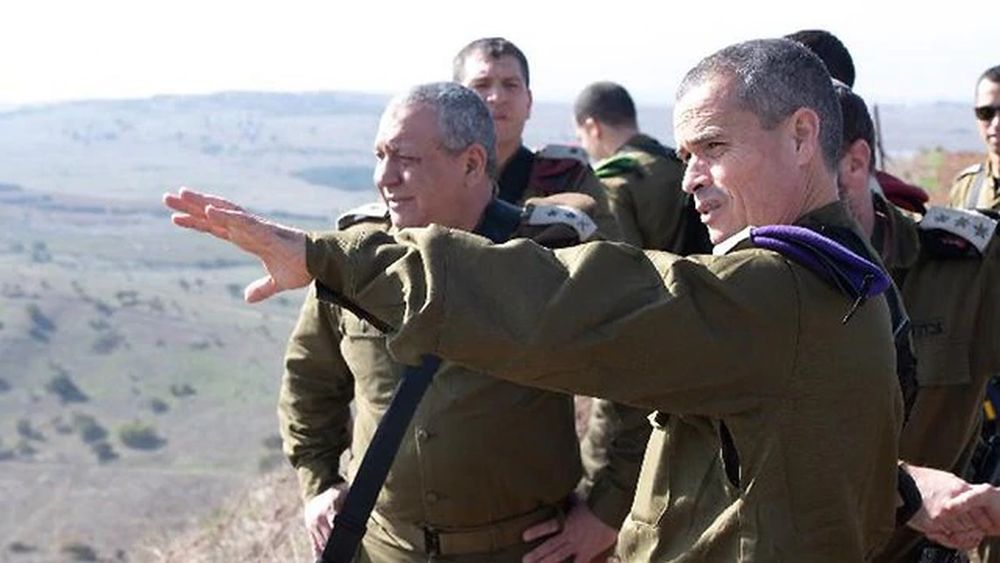Analysis/Israeli Army Chief’s Parting Message to Soleimani, Nasrallah and Khamenei
تحليل سياسي من الهآرتس بقلم انشيل بفيفر : رسالة وداع رئيس أركان جيش الدفاع الإسرائيلي إلى سليماني ونصرالله وخامنئي
Anshel Pfeffer/Haaretz/January 14/19
Gadi Eisenkot has long masked a no-longer secret war with Iran while making it clear to Tehran that all its efforts in Syria have amounted to nothing.
The commanders of few armies of ostensibly democratic countries have as prominent a public role as the outgoing chief of staff of the Israel Defense Forces. Each of them has been intensively conscious of that role, and in the wake of the unsuccessful Second Lebanon War – when part of the national criticism was reserved for the IDF’s exaggerated PR – the three men to have filled the post have reined back their media appearances.
Gabi Ashkenazi, Benny Gantz and Gadi Eisenkot gave only a tiny handful of on-the-record interviews during their terms. The message was, “We’re too busy preparing the IDF for the next war to indulge the media.”
It was, of course, a slightly misleading message as all three men regularly briefed journalists off-record; Ashkenazi especially was obsessed by his media image.
One result of this self-imposed purdah is that when the chiefs of staff do decide to give interviews, usually toward the end of their term, they carry more public significance and sum up a prolonged period of operational activity.
Lt. Gen. Eisenkot chose to give a round of television interviews over the past week to the main Israeli channels, to mark the end of his four-year term. And for the first time in over a decade, an IDF chief of staff granted an interview to two foreign media outlets – The New York Times and the Sunday Times. (Full disclosure, I was the interviewer for the Sunday Times.)
The Israeli interviews, naturally, were mainly aimed at the local public. They were a chance for Eisenkot – who ever since the Elor Azaria case (the Israeli soldier was found guilty of manslaughter in August 2017 after shooting a prone Palestinian assailant the previous year in Hebron) has been under intense criticism from right-wing politicians, and their proxies on social media – to respond to his critics.
He may not have been as aggressive as they had wished against the Palestinians, but he had been busy fighting a much more serious adversary. “When you fight for many years against a weak enemy, it also weakens you,” he said, explaining why he had pushed to confront Iran and Hezbollah instead of getting bogged down in unnecessary wars and intifadas in Gaza and the West Bank. Still in uniform, Eisenkot wouldn’t criticize his political masters. But it was also his way of answering them.
Through the foreign media, his message had two main targets: Iran’s Quds Force commander, Qassem Soleimani, and Hezbollah leader Hassan Nasrallah. For the past seven years, Israel’s attacks on Hezbollah and Iranian targets in Syria took place in what Eisenkot calls “an area of deniability,” to reduce their motive to retaliate.
Now the IDF has assessed that the Iranians have given up on their plan to establish permanent bases in Syria, and are instead focusing on trying to improve the accuracy of the missiles Hezbollah holds in Lebanon – and also create a similar proxy missile capability in Iraq – the time has come to disclose how Israel fought a secret war in Syria in these past years.
The details Eisenkot gave for the first time included Israel’s intelligence assessment in late 2016, with the tide turning against ISIS in Syria and Iraq, that Iran was moving to take advantage of the vacuum and establish a permanent force of up to 100,000 Shi’ite fighters under its control within Syria and a permanent presence at all Syrian air force bases.
The assessment and operational plans were presented to the cabinet, which gave the green light.
Up until then, Israel had directed its Syrian operations against Hezbollah weapons convoys and depots. From January 2017, it began directly striking Iranian targets in Syria as well. The attacks were mainly against Iranian “infrastructure,” trying to avoid casualties so as not to give the Iranians further reasons to escalate. Eisenkot said that only “a few dozen Iranians” were killed.
Following the Iranian decision to send an armed drone into Israeli airspace in February 2018, the gloves were taken off and in strikes against the airbase from which the drone had been launched, 10 Iranians were killed, including a colonel in the Revolutionary Guards. Eisenkot said the campaign included “thousands of attacks” on Iranian targets, not only from the air but also special-operations commando raids.
He also confirmed for the first time that Israel had supplied local rebel groups with small arms for “self-defense” – as part of its aid program to the Syrians living near its border on the Golan Heights, in areas where Iran was trying to establish a foothold.
Two years into the no-longer secret war with Iran – and it is still ongoing – Eisenkot mentioned one of the most recent strikes, last week, against an Iranian listening post at Tel el Qudne on the Golan.
The policy of Israeli opaqueness is well and truly over and on Sunday morning Prime Minister Benjamin Netanyahu got in on the act as well, boasting about an Israeli attack on Iranian arms shipments on Friday night, saying that “the accumulation of recent attacks proves that we are determined more than ever to take action against Iran in Syria” – lest anyone dare forget there is someone above the IDF chief of staff calling the shots.
There’s no point in hiding the campaign any longer. Iran tried to retaliate twice – with an armed drone attack last February and another rocket attack in May: Both were detected by Israel in advance and failed to cause any damage or casualties. And besides, Iran has apparently given up on establishing permanent bases in Syria and has now changed strategy. The Islamic Republic is trying to supply its proxies, Hezbollah in Lebanon and Iraq, with more accurate missiles with which to target Israel.
What was Eisenkot’s message, besides the understandable desire to take a bit of credit for himself after 40 years in uniform?
Eisenkot sought to make it clear to Nasrallah, to his paymaster Soleimani and to Soleimani’s boss back in Tehran, Supreme Leader Ali Khamenei, that they had wasted the last eight years. They may have succeeded in ensuring the survival of the Assad regime, killing half a million Syrians in the process, but it cost them $16 billion, at least 2,000 dead Hezbollah fighters and thousands more poor Shia mercenaries, flown in from Afghanistan, Pakistan and Iraq.
And now they have little to show for it. No Iranian airfields in Syria, no Mediterranean port, no advanced missile launchers. The wider message was to the people of Iran and the Shi’ite community in Lebanon – who bore the financial brunt of the war in Syria – that it simply wasn’t worth it.
This alone, of course, will not bring to an end the Revolutionary Guards’ stranglehold over life in Iran and Hezbollah’s hegemony in Beirut. But it will have a lasting effect.





















